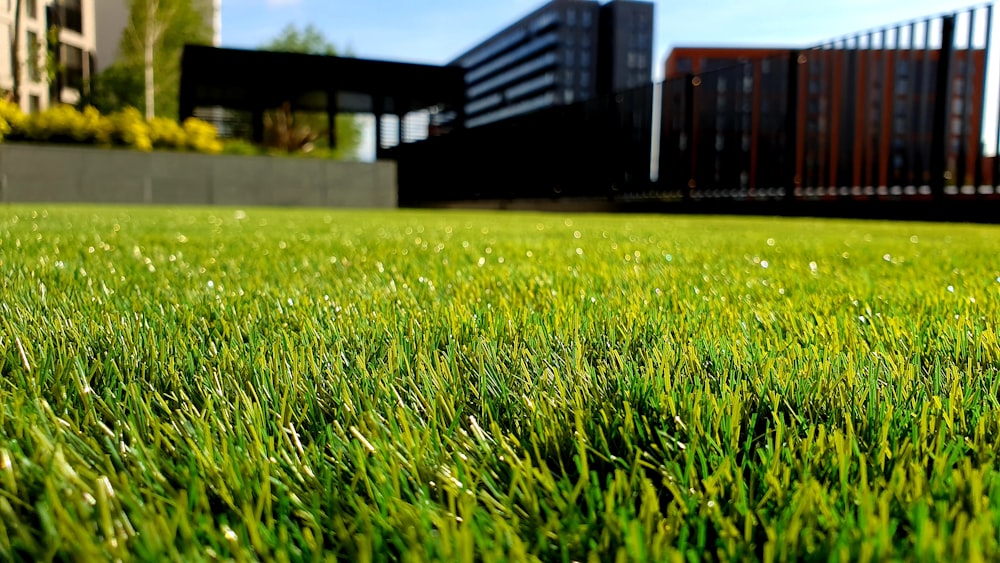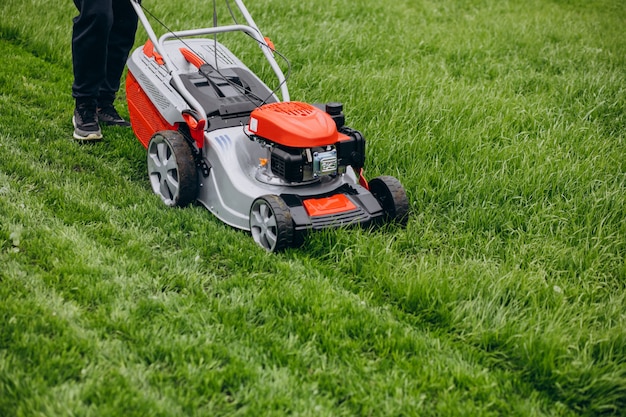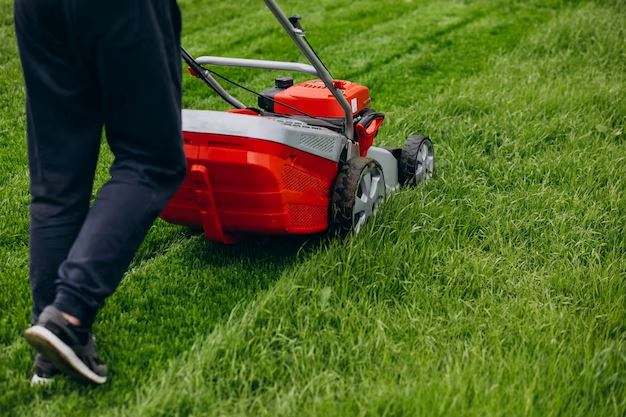Welcome to our comprehensive guide to sanding your lawn! If you're wondering why sanding is so important and how it benefits your lawn, you've come to the right place.
In this article, we'll guide you through the world of lawn sanding, explain its many benefits and give you an insight into the best techniques and practices. Prepare to learn everything you need to know about this essential maintenance procedure to keep your lawn healthy and vibrant.

The basics of lawn sanding: importance and positive effects
Lawn sanding is a maintenance measure that is often underestimated, but can be crucial for the health of your lawn. Simply put, sanding means applying a layer of sand to your lawn. This method not only improves the soil structure, but also promotes lawn growth. The sand helps to loosen compaction in the soil, which leads to better aeration and water permeability.
These improved conditions allow the grass roots to grow deeper and more effectively, which in turn leads to a stronger and healthier lawn. In short, sanding the lawn is a key to a dense and vital green.
Soil optimization through turf sanding: A scientific insight
Sanding the lawn is more than just a gardening routine - it is a science that specifically improves soil quality and promotes drainage. By applying a layer of sand, the soil becomes looser and more permeable, which significantly improves water permeability and soil aeration. This change in the soil allows the roots to develop deeper and healthier, while also improving nutrient uptake.
The sand acts as a kind of mini drainage system that prevents waterlogging and ensures that nutrients reach where they are needed - the roots. This optimization of the soil composition is crucial for the growth of a robust, hardy lawn.
The perfect sand for your lawn: Selection and criteria
Quartz sand: The ideal material for lawn care
Silica sand plays a central role in sanding your lawn. This type of sand is known for its purity and uniform grain size, which makes it ideal for lawn care. Silica sand is characterized by its low clay and loam content, which means that it does not contribute to soil compaction. Instead, it promotes drainage and aeration of the soil, which is essential for healthy root growth and therefore a strong lawn.
The importance of grain size and purity
The grain size of the sand is another decisive factor. A grain size between 0.5 and 1.5 mm is ideal, as this size offers the best balance between soil loosening and stability. Sand that is too fine can cause the soil to clump together, while sand that is too coarse is less effective at improving soil structure.
The purity of the sand is equally important, as impurities such as organic matter or other foreign particles can reduce the positive effects of the sand. Therefore, make sure to choose high-quality and clean silica sand to achieve the best results for your lawn.
The best time to sand the lawn: When and why?
The ideal time to sand your lawn is during the transitional periods of the year - spring and fall. These periods are particularly favorable as the lawn is actively growing during these times and recovering from stress, such as extreme summer heat or winter cold. Sanding in spring prepares your lawn for the coming growing season, while sanding in fall helps prepare the lawn for the colder months.
When sanding lawns, it is important to take into account the growth of the lawn. During the growth phases, the lawn is at its strongest and most capable of regeneration, which makes it ideal for sanding. Outside of these periods, especially in midsummer or in the depths of winter, sanding can put additional stress on the lawn and should therefore be avoided. By adapting the time of sanding to the natural growth of your lawn, you promote the health and robustness of your green space.

Effective preparation: How to prepare your lawn for sanding
Mowing, scarifying and aerating: The basics
Before you start sanding the lawn, thorough preparation of the lawn is essential. Start by mowing the lawn to ensure an even height. This not only makes it easier to apply the sand evenly, but also to penetrate the turf. You should then scarify to remove thatch and moss and improve aeration of the soil. Aerating, i.e. making small holes in the soil, is also recommended as it increases water permeability and allows the sand to penetrate deeper into the soil.
The importance of thorough cleaning
An important, often overlooked step before sanding is to thoroughly clean the lawn. Remove all types of debris, leaves or branches. This cleaning ensures that the sand comes into direct contact with the soil and can develop its full effect. A clean lawn allows for more efficient soil improvement and ensures that your lawn sanding efforts produce the best results.
Precise lawn sanding: A step-by-step guide
Even distribution of the sand: the first step to success
Once your lawn has been prepared before sanding and the soil has been optimally worked, the actual sanding process begins. An even distribution of the sand is crucial to effectively improve the soil. To do this, use a spreader or spread the sand evenly over the lawn in small piles.
Make sure that you don't apply too much sand at once, as too thick a layer of sand can suffocate the lawn. As a rule of thumb: about 3-4 liters of sand per square meter.
Techniques for optimum incorporation of the sand
Once the sand has been evenly distributed, it is important to work it in correctly. Use a lawn brush or a special Rasenrakel to gently work the sand into the turf. This technique works the sand deeper into the soil and reaches the root zone of the lawn. The incorporation should be done carefully to ensure that the sand is evenly distributed into the soil and that no areas of the lawn are over or under sanded. This step is crucial to take full advantage of the positive effects of sand, such as improved drainage and soil structure.
Optimum dosage and intervals when sanding lawns
The frequency and amount of sanding depends heavily on the soil type of your lawn. Light, sandy soils require less frequent sanding than heavy, clayey soils. Sanding every two to three years is often sufficient for sandy soils, while clayey soils may require annual sanding. This helps to improve the soil structure and prevent compaction.
Quantities for effective application
In terms of quantity, it is recommended to use around 10 to 15 liters of sand per square metre when sanding the lawn. This amount ensures that the sand penetrates deep enough into the soil to effectively improve the soil structure without smothering the lawn. Adjusting the amount of sand to your specific lawn and soil type will ensure the best results when sanding your lawn.

Effective aftercare: lawn care after sanding
After sanding, proper care of your lawn is crucial. Adequate watering helps the sand to settle into the soil and supports root growth. Water your lawn regularly, especially in the first few weeks after sanding. The water should penetrate deep into the soil, ideally to a depth of 10 to 15 cm per m².
pH adjustment and nutrient management
It is also important to monitor the pH of the soil after sanding. Sand can easily change the pH, so a soil analysis may be necessary to determine if an adjustment is needed. Fertilization plays an important role in providing your lawn with the nutrients it needs. Use a high quality fertilizer to ensure your lawn receives all the essential nutrients. These steps are crucial to ensure your lawn remains healthy and strong after sanding.
Common mistakes when sanding lawns and how to avoid them
A common mistake when sanding is overlooking waterlogging and soil compaction. To avoid this, it is important to use the right amount of sand and make sure your soil has good drainage. Too much sand can lead to compaction, which impairs air and water circulation. A well-designed distribution of sand across the lawn can minimize this problem.
Another common mistake is neglecting lawn cutting and regular maintenance, which can lead to moss and weed growth. To prevent this, it is important to mow your lawn regularly and adjust the cutting height to promote healthy growth. In addition, targeted fertilization can help to optimize the lawn's nutrient supply and effectively combat unwanted moss and weeds. By following these tips, you can ensure that your lawn remains in top condition after sanding.
Final thoughts: The key to your dream lawn
To conclude our comprehensive guide to lawn sanding, we would like to highlight the most important points once again. Remember that sanding is an essential maintenance measure that not only improves the condition of the soil, but also promotes lawn growth. Choose the right sand, pay attention to the right time and quantity and don't forget the important preparation of the lawn before sanding. After sanding, careful maintenance is crucial. Avoid common mistakes and remain consistent in your aftercare.
We hope this guide will help you to get and keep your lawn in top shape. Get motivated and start now - your dream lawn is waiting to become a reality!




